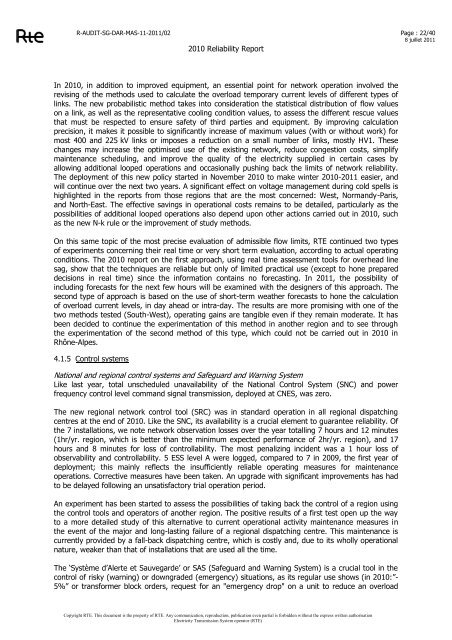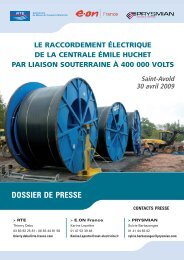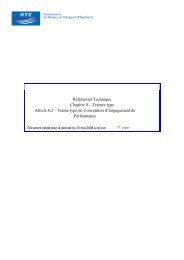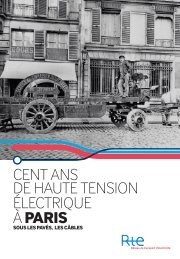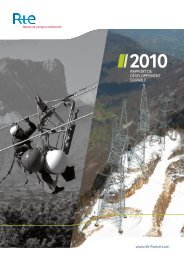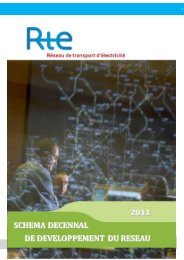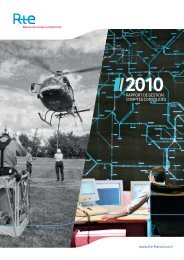Power System Reliability Report - RTE
Power System Reliability Report - RTE
Power System Reliability Report - RTE
- No tags were found...
Create successful ePaper yourself
Turn your PDF publications into a flip-book with our unique Google optimized e-Paper software.
R-AUDIT-SG-DAR-MAS-11-2011/022010 <strong>Reliability</strong> <strong>Report</strong>Page : 22/408 juillet 2011In 2010, in addition to improved equipment, an essential point for network operation involved therevising of the methods used to calculate the overload temporary current levels of different types oflinks. The new probabilistic method takes into consideration the statistical distribution of flow valueson a link, as well as the representative cooling condition values, to assess the different rescue valuesthat must be respected to ensure safety of third parties and equipment. By improving calculationprecision, it makes it possible to significantly increase of maximum values (with or without work) formost 400 and 225 kV links or imposes a reduction on a small number of links, mostly HV1. Thesechanges may increase the optimised use of the existing network, reduce congestion costs, simplifymaintenance scheduling, and improve the quality of the electricity supplied in certain cases byallowing additional looped operations and occasionally pushing back the limits of network reliability.The deployment of this new policy started in November 2010 to make winter 2010-2011 easier, andwill continue over the next two years. A significant effect on voltage management during cold spells ishighlighted in the reports from those regions that are the most concerned: West, Normandy-Paris,and North-East. The effective savings in operational costs remains to be detailed, particularly as thepossibilities of additional looped operations also depend upon other actions carried out in 2010, suchas the new N-k rule or the improvement of study methods.On this same topic of the most precise evaluation of admissible flow limits, <strong>RTE</strong> continued two typesof experiments concerning their real time or very short term evaluation, according to actual operatingconditions. The 2010 report on the first approach, using real time assessment tools for overhead linesag, show that the techniques are reliable but only of limited practical use (except to hone prepareddecisions in real time) since the information contains no forecasting. In 2011, the possibility ofincluding forecasts for the next few hours will be examined with the designers of this approach. Thesecond type of approach is based on the use of short-term weather forecasts to hone the calculationof overload current levels, in day ahead or intra-day. The results are more promising with one of thetwo methods tested (South-West), operating gains are tangible even if they remain moderate. It hasbeen decided to continue the experimentation of this method in another region and to see throughthe experimentation of the second method of this type, which could not be carried out in 2010 inRhône-Alpes.4.1.5 Control systemsNational and regional control systems and Safeguard and Warning <strong>System</strong>Like last year, total unscheduled unavailability of the National Control <strong>System</strong> (SNC) and powerfrequency control level command signal transmission, deployed at CNES, was zero.The new regional network control tool (SRC) was in standard operation in all regional dispatchingcentres at the end of 2010. Like the SNC, its availability is a crucial element to guarantee reliability. Ofthe 7 installations, we note network observation losses over the year totalling 7 hours and 12 minutes(1hr/yr. region, which is better than the minimum expected performance of 2hr/yr. region), and 17hours and 8 minutes for loss of controllability. The most penalizing incident was a 1 hour loss ofobservability and controllability. 5 ESS level A were logged, compared to 7 in 2009, the first year ofdeployment; this mainly reflects the insufficiently reliable operating measures for maintenanceoperations. Corrective measures have been taken. An upgrade with significant improvements has hadto be delayed following an unsatisfactory trial operation period.An experiment has been started to assess the possibilities of taking back the control of a region usingthe control tools and operators of another region. The positive results of a first test open up the wayto a more detailed study of this alternative to current operational activity maintenance measures inthe event of the major and long-lasting failure of a regional dispatching centre. This maintenance iscurrently provided by a fall-back dispatching centre, which is costly and, due to its wholly operationalnature, weaker than that of installations that are used all the time.The „Système d‟Alerte et Sauvegarde‟ or SAS (Safeguard and Warning <strong>System</strong>) is a crucial tool in thecontrol of risky (warning) or downgraded (emergency) situations, as its regular use shows (in 2010:”-5%” or transformer block orders, request for an "emergency drop" on a unit to reduce an overloadCopyright <strong>RTE</strong>. This document is the property of <strong>RTE</strong>. Any communication, reproduction, publication even partial is forbidden without the express written authorisationElectricity Transmission <strong>System</strong> operator (<strong>RTE</strong>)


